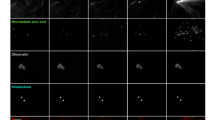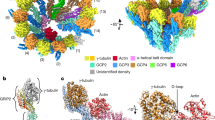Abstract
Microtubules are dynamic polymers that move stochastically between periods of growth and shrinkage, a property known as dynamic instability. Here, to investigate the mechanisms regulating microtubule dynamics in Xenopus egg extracts, we have cloned the complementary DNA encoding the microtubule-associated protein XMAP215 and investigated the function of the XMAP215 protein. Immunodepletion of XMAP215 indicated that it is a major microtubule-stabilizing factor in Xenopus egg extracts. During interphase, XMAP215 stabilizes microtubules primarily by opposing the activity of the destabilizing factor XKCM1, a member of the kinesin superfamily. These results indicate that microtubule dynamics in Xenopus egg extracts are regulated by a balance between a stabilizing factor, XMAP215, and a destabilizing factor, XKCM1.
This is a preview of subscription content, access via your institution
Access options
Subscribe to this journal
Receive 12 print issues and online access
$209.00 per year
only $17.42 per issue
Buy this article
- Purchase on Springer Link
- Instant access to full article PDF
Prices may be subject to local taxes which are calculated during checkout







Similar content being viewed by others
References
Mitchison, T. & Kirschner, M. Dynamic instability of microtubule growth. Nature 312, 237– 242 (1984).
Desai, A. & Mitchison, T. J. Microtubule polymerization dynamics. Annu. Rev. Cell. Dev. Biol. 13, 83–117 (1997).
Walker, R. A. et al. Dynamic instability of individual microtubules analyzed by video light microscopy: rate constants and transition frequencies. J. Cell Biol. 107, 1437–1448 (1988).
Cassimeris, L. Accessory protein regulation of microtubule dynamics throughout the cell cycle . Curr. Opin. Cell Biol. 11, 134– 141 (1999).
Vasquez, R. J., Gard, D. L. & Cassimeris, L. XMAP from Xenopus eggs promotes rapid plus end assembly of microtubules and rapid microtubule polymer turnover. J. Cell Biol. 127, 985–993 ( 1994).
Vasquez, R. J., Gard, D. L. & Cassimeris, L. Phosphorylation by CDK1 regulates XMAP215 function in vitro. Cell Motil Cytoskel. 43, 310– 321 (1999).
Andersen, S. S., Buendia, B., Dominguez, J. E., Sawyer, A. & Karsenti, E. Effect on microtubule dynamics of XMAP230, a microtubule-associated protein present in Xenopus laevis eggs and dividing cells. J. Cell Biol. 127, 1289 –1299 (1994).
Andersen, S. S. & Karsenti, E. XMAP310: a Xenopus rescue-promoting factor localized to the mitotic spindle. J. Cell Biol. 139, 975–983 ( 1997).
Belmont, L. D. & Mitchison, T. J. Identification of a protein that interacts with tubulin dimers and increases the catastrophe rate of microtubules . Cell 84, 623–631 (1996).
Walczak, C. E., Mitchison, T. J. & Desai, A. XKCM1: a Xenopus kinesin-related protein that regulates microtubule dynamics during mitotic spindle assembly. Cell 84, 37–47 (1996).
Curmi, P. A. et al. The stathmin/tubulin interaction in vitro. J. Biol. Chem. 272, 25029–25036 ( 1997).
Desai, A., Verma, S., Mitchison, T. J. & Walczak, C. E. Kin I kinesins are microtubule-destabilizing enzymes. Cell 96, 69–78 (1999).
Howell, B., Larsson, N., Gullberg, M. & Cassimeris, L. Dissociation of the tubulin-sequestering and microtubule catastrophe-promoting activities of oncoprotein 18/stathmin. Mol. Biol. Cell 10, 105–118 (1999).
Gard, D. L. & Kirschner, M. W. A microtubule-associated protein from Xenopus eggs that specifically promotes assembly at the plus-end. J. Cell Biol. 105, 2203–2215 (1987).
Charrasse, S. et al. The TOGp protein is a new human microtubule-associated protein homologous to the Xenopus XMAP215. J. Cell Sci. 111 , 1371–1383 (1998).
Fiona Cullen, C., Deák, P., Glover, D. M. & Ohkura, H. mini spindles: a gene encoding a conserved microtubule-associated protein required for the integrity of the mitotic spindle in Drosophila. J. Cell Biol. 146, 1005–1018 (1999).
Matthews, L. R., Carter, P., Thierry-Mieg, D. & Kemphues, K. ZYG-9, a Caenorhabditis elegans protein required for microtubule organization and function, is a component of meiotic and mitotic spindle poles. J. Cell Biol. 141, 1159–1168 (1998).
Wang, P. J. & Huffaker, T. C. Stu2p: a microtubule-binding protein that is an essential component of the yeast spindle pole body. J. Cell Biol. 139, 1271–1280 (1997).
Nabeshima, K. et al. p93dis1, which is required for sister chromatid separation, is a novel microtubule and spindle pole body-associating protein phosphorylated at the Cdc2 target sites. Genes Dev. 9, 1572–1585 (1995).
Nakaseko, Y., Nabeshima, K., Kinoshita, K. & Yanagida, M. Dissection of fission yeast microtubule associating protein p93Dis1: regions implicated in regulated localization and microtubule interaction. Genes Cells 1, 633–644 ( 1996).
Ohkura, H. et al. Cold-sensitive and caffeine-supersensitive mutants of the Schizosaccharomyces pombe dis genes implicated in sister chromatid separation during mitosis. EMBO J. 7, 1465– 1473 (1988).
Charrasse, S. et al. Characterization of the cDNA and pattern of expression of a new gene over-expressed in human hepatomas and colonic tumors. Eur. J. Biochem. 234, 406–413 (1995).
Nagase, T. et al. Prediction of the coding sequences of unidentified human genes. III. The coding sequences of 40 new genes (KIAA0081-KIAA0120) deduced by analysis of cDNA clones from human cell line KG-1. DNA Res. 2, 37–43 (1995).
Andrade, M. A. & Bork, P. HEAT repeats in the Huntington’s disease protein. Nature Genet. 11 , 115–116 (1995).
Drewes, G., Ebneth, A., Preuss, U., Mandelkow, E. M. & Mandelkow, E. MARK, a novel family of protein kinases that phosphorylate microtubule-associated proteins and trigger microtubule disruption. Cell 89, 297–308 ( 1997).
Aizawa, H. et al. Molecular cloning of a ubiquitously distributed microtubule-associated protein with Mr 190,000. J. Biol. Chem. 265, 13849–13855 (1990).
Chapin, S. J. & Bulinski, J. C. Non-neuronal 210 x 10(3) Mr microtubule-associated protein (MAP4) contains a domain homologous to the microtubule-binding domains of neuronal MAP2 and tau. J. Cell Sci. 98, 27–36 ( 1991).
Goedert, M., Wischik, C. M., Crowther, R. A., Walker, J. E. & Klug, A. Cloning and sequencing of the cDNA encoding a core protein of the paired helical filament of Alzheimer disease: identification as the microtubule-associated protein tau. Proc. Natl Acad. Sci. USA 85, 4051–4055 (1988).
West, R. R., Tenbarge, K. M. & Olmsted, J. B. A model for microtubule-associated protein 4 structure. Domains defined by comparisons of human, mouse, and bovine sequences. J. Biol. Chem. 266, 21886–21896 (1991).
Tournebize, R. et al. Distinct roles of PP1 and PP2A-like phosphatases in control of microtubule dynamics during mitosis. EMBO J. 16, 5537–5549 (1997).
Wilde, A. & Zheng, Y. Stimulation of microtubule aster formation and spindle assembly by the small GTPase Ran. Science 284, 1359–1362 (1999).
Shiina, N., Moriguchi, T., Ohta, K., Gotoh, Y. & Nishida, E. Regulation of a major microtubule-associated protein by MPF and MAP kinase. EMBO J. 11, 3977– 3984 (1992).
Diamantopoulos, G. S. et al. Dynamic localization of CLIP-170 to microtubule plus ends is coupled to microtubule assembly. J. Cell Biol. 144 , 99–112 (1999).
Perez, F., Diamantopoulos, G. S., Stalder, R. & Kreis, T. E. CLIP-170 highlights growing microtubule ends in vivo. Cell 96, 517–527 (1999).
Vaughan, K. T., Tynan, S. H., Faulkner, N. E., Echeverri, C. J. & Vallee, R. B. Colocalization of cytoplasmic dynein with dynactin and CLIP-170 at microtubule distal ends. J. Cell Sci. 112, 1437–1447 (1999).
Severin, F. F., Sorger, P. K. & Hyman, A. A. Kinetochores distinguish GTP from GDP forms of the microtubule lattice. Nature 388, 888– 891 (1997).
Andersen, S. S. et al. Mitotic chromatin regulates phosphorylation of Stathmin/Op18 . Nature 389, 640–643 (1997).
Verde, F., Dogterom, M., Stelzer, E., Karsenti, E. & Leibler, S. Control of microtubule dynamics and length by cyclin A- and cyclin B- dependent kinases in Xenopus egg extracts . J. Cell Biol. 118, 1097– 1108 (1992).
Frohman, M. A., Dush, M. K. & Martin, G. R. Rapid production of full-length cDNAs from rare transcripts: amplification using a single gene-specific oligonucleotide primer. Proc. Natl Acad. Sci. USA 85, 8998– 9002 (1988).
Harlow, E. & Lane, D. Antibodies : a Laboratory Manual (Cold Spring Harb. Lab. Press, Cold Spring Harbor, 1988).
Murray, A. W. in Xenopus laevis: Practical Uses in Cell and Molecular Biology (eds Kay, B. K. & Peng, H. B.) 581–605 (Academic, San Diego, 1991).
Sawin, K. E. & Mitchison, T. J. Mitotic spindle assembly by two different pathways in vitro. J. Cell Biol. 112, 925–940 (1991).
Field, C. M., Oegema, K., Zheng, Y., Mitchison, T. J. & Walczak, C. E. Purification of cytoskeletal proteins using peptide antibodies. Methods Enzymol. 298, 525– 541 (1998).
Acknowledgements
We thank F. Senger for cell culture; D. Drechsel for help during protein purification; A. Shevchenko and A. Shevchenko for mass spectrometry analysis; A. Desai for stimulating discussions and advice; and A. Desai, I. Sassoon, P. Gönczy, K. Oegema, M. Rathman, M. Mavris and C. Gonzalez for critical reading of the manuscript. A.P. was supported by an EMBO long-term and an HSFPO long-term fellowship. K.K. was supported by an HFSPO long-term fellowship.
Correspondence and requests for materials should be addressed to A.A.H. The XMAP215 cDNA sequence has been submitted to EMBL Nucleotide Sequence Database under accession number AJ251130.
Author information
Authors and Affiliations
Corresponding author
Rights and permissions
About this article
Cite this article
Tournebize, R., Popov, A., Kinoshita, K. et al. Control of microtubule dynamics by the antagonistic activities of XMAP215 and XKCM1 in Xenopus egg extracts. Nat Cell Biol 2, 13–19 (2000). https://doi.org/10.1038/71330
Received:
Revised:
Accepted:
Published:
Issue Date:
DOI: https://doi.org/10.1038/71330
This article is cited by
-
Microtubule nucleation and γTuRC centrosome localization in interphase cells require ch-TOG
Nature Communications (2023)
-
Regulation of microtubule dynamics, mechanics and function through the growing tip
Nature Reviews Molecular Cell Biology (2021)
-
XMAP215 is a microtubule nucleation factor that functions synergistically with the γ-tubulin ring complex
Nature Cell Biology (2018)
-
Mitotic spindle assembly in animal cells: a fine balancing act
Nature Reviews Molecular Cell Biology (2017)
-
Microtubule nucleation: beyond the template
Nature Reviews Molecular Cell Biology (2017)



